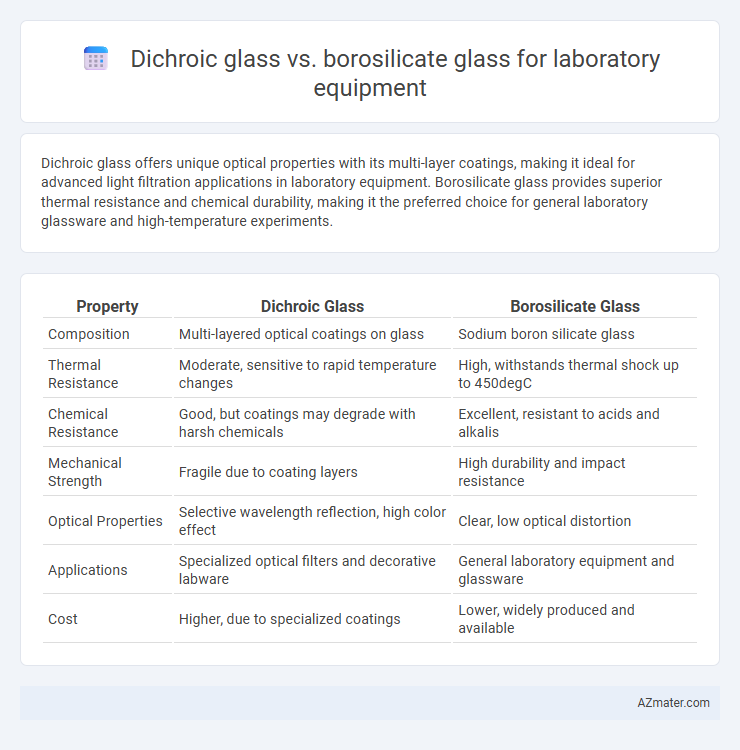Dichroic glass offers unique optical properties with its multi-layer coatings, making it ideal for advanced light filtration applications in laboratory equipment. Borosilicate glass provides superior thermal resistance and chemical durability, making it the preferred choice for general laboratory glassware and high-temperature experiments.
Table of Comparison
| Property | Dichroic Glass | Borosilicate Glass |
|---|---|---|
| Composition | Multi-layered optical coatings on glass | Sodium boron silicate glass |
| Thermal Resistance | Moderate, sensitive to rapid temperature changes | High, withstands thermal shock up to 450degC |
| Chemical Resistance | Good, but coatings may degrade with harsh chemicals | Excellent, resistant to acids and alkalis |
| Mechanical Strength | Fragile due to coating layers | High durability and impact resistance |
| Optical Properties | Selective wavelength reflection, high color effect | Clear, low optical distortion |
| Applications | Specialized optical filters and decorative labware | General laboratory equipment and glassware |
| Cost | Higher, due to specialized coatings | Lower, widely produced and available |
Introduction to Laboratory Glass Materials
Dichroic glass and borosilicate glass serve different purposes in laboratory settings due to their distinct physical and chemical properties. Borosilicate glass is renowned for its thermal resistance, chemical durability, and low thermal expansion, making it ideal for laboratory equipment exposed to heat and corrosive substances. Dichroic glass, characterized by its multi-layer optical coatings, is primarily used in specialized optical applications rather than general labware, where thermal and chemical resistance are critical.
What is Dichroic Glass?
Dichroic glass is a specialized material featuring multiple ultra-thin layers of metal oxides, which create distinct optical effects by selectively reflecting and transmitting specific wavelengths of light. Unlike borosilicate glass, known for its thermal resistance and chemical durability, dichroic glass is primarily used for its unique color-changing properties and spectral filtering capabilities in laboratory optical instruments. This makes dichroic glass essential for applications requiring precise light manipulation, such as beam splitters, filters, and microscopy components.
What is Borosilicate Glass?
Borosilicate glass is a highly durable, heat-resistant glass composed primarily of silica and boron trioxide, making it ideal for laboratory equipment due to its low thermal expansion and chemical stability. Unlike dichroic glass, which is primarily used for decorative and optical applications because of its light-filtering properties, borosilicate glass withstands rapid temperature changes and corrosive substances encountered during experiments. Its exceptional resistance to thermal shock and chemical corrosion ensures reliable performance in scientific glassware such as beakers, test tubes, and flasks.
Chemical Composition Comparison
Dichroic glass contains multiple ultra-thin layers of metal oxides such as titanium, chromium, and iron, offering unique optical properties but limited chemical resistance compared to borosilicate glass, which primarily consists of silica and boron trioxide. Borosilicate glass exhibits superior thermal and chemical stability, showing strong resistance to acids, bases, and thermal shock, making it ideal for laboratory equipment. The chemical inertness of borosilicate glass ensures minimal interaction with reactive substances, whereas dichroic glass is more prone to surface degradation in aggressive chemical environments.
Thermal Resistance and Stability
Borosilicate glass exhibits superior thermal resistance and stability compared to dichroic glass, with a low coefficient of thermal expansion (~3.3 x 10^-6 /degC) allowing it to withstand rapid temperature changes up to 500degC without cracking. Dichroic glass, primarily used for optical and decorative purposes, has lower thermal shock resistance and can fracture under sudden temperature fluctuations. Laboratory equipment demands the high durability and consistent thermal performance of borosilicate glass for reliable results and operational safety.
Optical Properties and Applications
Dichroic glass exhibits unique optical properties such as selective wavelength reflection and transmission, making it ideal for applications requiring precise light filtering and color separation in laboratory optics. Borosilicate glass offers superior thermal and chemical resistance with high optical clarity, making it the preferred choice for durable labware like beakers, test tubes, and microscope slides. These contrasting optical characteristics determine their specialized use: dichroic glass in optical devices and sensors, and borosilicate glass in general laboratory equipment demanding robustness and transparency.
Mechanical Strength and Durability
Borosilicate glass is favored in laboratory equipment for its superior mechanical strength and thermal resistance, with a low coefficient of thermal expansion (3.3 x 10-6 /degC) that minimizes stress from temperature changes. Dichroic glass, while primarily used for its optical properties, exhibits lower mechanical strength and is more prone to fracturing under thermal or mechanical stress. For durability and heavy-duty laboratory applications, borosilicate glass outperforms dichroic glass due to its robustness and resistance to chemical corrosion.
Cost and Availability in Laboratories
Dichroic glass is generally more expensive and less commonly available in laboratory settings compared to borosilicate glass, which is widely produced and cost-effective for general use. Borosilicate glass offers excellent chemical resistance and thermal stability, making it the preferred choice for most laboratory equipment due to its affordability and widespread supply. Laboratories typically stock borosilicate glassware extensively, while dichroic glass remains specialized and harder to procure for routine applications.
Suitability for Scientific Procedures
Dichroic glass, known for its light-filtering properties, is rarely used in laboratory equipment due to its specialized optical functions rather than chemical resistance or thermal durability. Borosilicate glass offers superior suitability for scientific procedures because of its excellent thermal stability, chemical inertness, and resistance to thermal shock, making it ideal for test tubes, beakers, and other labware. Laboratories prioritize borosilicate glass for accurate experiments and safety under high-temperature or corrosive conditions.
Choosing the Right Glass for Laboratory Equipment
Dichroic glass offers unique optical properties with its light-filtering capabilities, making it suitable for specialized laboratory equipment requiring selective light transmission. Borosilicate glass, known for its exceptional thermal resistance and chemical durability, remains the preferred choice for standard laboratory glassware due to its ability to withstand high temperatures and corrosive substances. Selecting the right glass involves assessing the experimental conditions, such as exposure to heat, chemicals, and light, to ensure optimal performance and durability.

Infographic: Dichroic glass vs Borosilicate glass for Laboratory equipment
 azmater.com
azmater.com